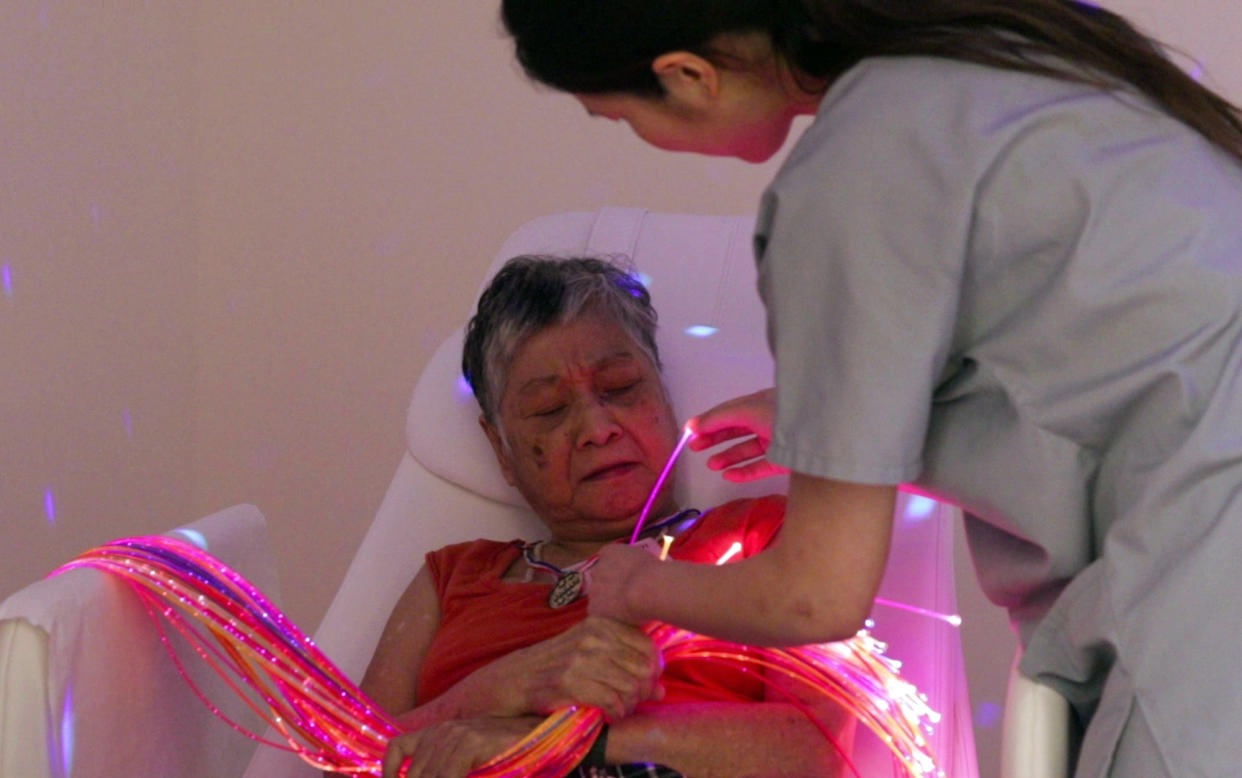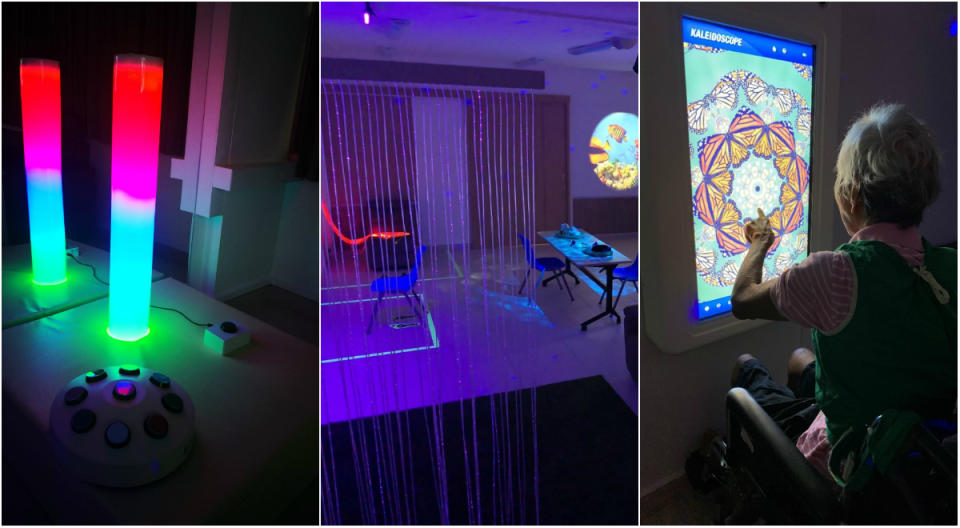Resident homes embrace multi-sensory spaces to help people with dementia

SINGAPORE — “I used to wear red, orange and chocolate coloured clothes to work. My favourite colour is green,” said Chua Mui Noi, 69, in Mandarin, as she deftly picked at fibre optic strands lit up in eye-catching shades.
“So cute. Is that a boy or girl? I love kids,” she later cooed softly to a cheeky-looking baby boy doll nicknamed Nathaniel, while lying down on a leather chair that rocked to nature music.
Speaking to her therapist, she asked, “Is the boy currently attending school? He looks like he is about eight years old.”
In a room illuminated with soft hues, Chua’s bold orange tank top and chatter – sometimes, lucid, other times, confusing – were unmistakable.
Occasionally, her conversations took on a dour tone. “Did they tell you about my bad leg? Was it my mother – is she coming to see me? I have never seen her before in my life,” she mused.
When the lights came back on, marking the conclusion of her time on the chair, Chua eased her way to a “sensory” wall for the next segment of her session.
The slight but sprightly woman wore various items dear to her: a reedy beaded necklace, a black plastic watch with its face pointing away from her, and a slightly-worn medallion.
Inscribed on the last accessory was the word “winner”, a memento earned by Chua from a group song & dance talent show for dementia residents at Orange Valley Balestier Care Centre.
Snoezelen in S’pore
The multi-sensory room – also known as Snoezelen – is part of a therapy offered at the centre to aid individuals, like Chua, with dementia.
Snoezelen, which is a blend of two Dutch words meaning "explore" and "relax", was first developed in the Netherlands in the 1970s to deliver stimulation through lights, colour, sound, and scent in a controlled environment.
Initially designed for those with autism and other developmental disabilities, it has been in recent years used as part of treatment for those with dementia.
While snoezelen rooms have been commonly available in European countries for decades, they have only been making inroads in Singapore in recent years, in tandem with the rising number of people with dementia.
One in 10 aged 60 and above in Singapore have dementia, according to a 2013 Institute of Mental Health study. This translates to an estimated 82,000 cases locally last year, with the number expected to increase to 130,000 to 140,000 by 2030.
In Orange Valley Balestier Care Centre’s case, it converted an 8.8sqm outpatient consultation room into a snoezelen room and rolled out its efforts in June.
Over 20 residents suffering from moderate to severe dementia who are unable to participate in group activities take turns to visit the room, typically once a week for a one-and-a-half-hour session.
Jamie Choy, a therapist at the centre, stressed that each session plays out uniquely for each individual dementia patient.
“(Each resident) will respond to items differently, so the therapist will have to be sensitive to their needs and modify our interventions accordingly,” said the 32-year-old.
This can include first lying or sitting on the room’s star “attraction”, the Wellness Nordic Relax Chair, a fully-automated contraption that comes with a built-in audio system and three pre-set automatic programmes offering multi-sensory stimulation.

A “water effects” projector, a disco ball, and light fibre optic strands provide both visual and cognitive stimulation for the residents when they are asked to identify colours by the therapist.
A sensory wall made of different tactile materials, such as sponges, foam, pens and corrugated boards, encourages residents to “reactivate” their senses.
The residents may also be treated to “spa-like” treatment, such as gentle hand massages, hair brushing, and aromatherapy.
One of the main purposes of such rooms is to allow them to remain calm so they will be able to engage better with staff and family members, said Choy.
For instance, Chua often lapses into emotional outbursts and has been involved in heated arguments with nurses and other residents previously, Choy explained.
“She is more relaxed after a session, and it helps to calm her down,” she added. “The other important function of the room is to stimulate and reactivate the senses (of residents), so that they will be more alert and aware of their environment.”
Laurence Lee, managing partner of Ascension Group which distributes Wellness Nordic Relax Chair in Singapore, told Yahoo News Singapore that most of the five chairs they have brought in have been donated to healthcare institutions, such as Orange Valley Balestier Care Centre and the Alzheimer's Disease Association’s New Horizon Centre.
“Most healthcare institutions are accepting of the use of the chair for their patients but they hope to have funding in terms of grants and subsidies from the government,” said Lee.
Currently, Ascension is working with the National Council of Social Service to promote the use of the chair, priced at €12,000 (S$18,182) before GST, to social service organisations.

Positive impact on residents
Other homes here, such as AWWA Dementia Day Care, Vanguard Healthcare and THK Nursing Home, have also recently set up Snoezelen rooms.
The AWWA’s Yishun centre started its sensory therapy sessions in March, within a 20sqm room adorned with “retro” furniture, aquatic bubble tubes and interactive panels. These 30- to 45-minute sessions are typically conducted either one-on-one or in groups of two to four residents with moderate-to-severe dementia.
AWWA Health and Senior Care deputy director Sairam Azad told Yahoo News Singapore that the centre is still studying the effects and benefits of the therapy on its clients, noting that it would be helpful for those who have lost their ability to speak coherently.
While the therapy is a tool for service providers to engage persons with dementia, he stressed that training and development of professionals are critical to achieving successful outcomes, he added.
Over at Thye Hua Kwan Moral Society (THK) Nursing Home at Hougang, a 60sqm multi-sensory room, which was opened last year, is said to be the largest of its kind among nursing and disability homes here.
Its CEO Ardi S Hardjoe said that it is planning to open a second room of a similar size in January next year within the same home. Currently, the initiative has been expanded to a senior care centre at Kaki Bukit on a smaller scale.
The room in Hougang features sensory-stimulating objects, such as a giant LED rainbow tube and interactive panels with eight apps including those that encourage dementia residents to sort shapes and create “kaleidoscope” patterns during a one-hour session.
Such an approach was first used by the society to work with children with special needs in the disability sector, noted Hardjoe. The staff noticed some similarities between the children and those with dementia, especially in how they perform their activities of daily living, such as bathing, dressing and feeding, and social interaction.
“After researching the positive effects of multi-sensory stimulation for elderly with dementia overseas, we decided to install a room with the technology to replicate effects locally and evaluate the effectiveness,” he added.
Since the room was set up, over 50 participating residents have been observed to perform better in their activities of living, being more engaged in interactions and activities, and expressing more positivity.

Not just rooms to raise sensory perceptions
Others have converted parts of public spaces within their compounds into therapeutic gardens. Those at various NTUC Health, Vanguard Health Care and Apex Harmony Lodge homes and day centres allow residents – not just those with dementia – to engage in light exercises and grow plants.
At Apex Harmony Lodge, the residents are given visual reminders of their life history through personalised headboards, said its corporate development executive Ng Wei Xuan.
“An effort is ongoing to select specific plants with varying colours, textures and smells aimed at stimulating residents’ senses during their routine garden walks,” Ng added.
Across nursing homes in Singapore, there are also initiatives being undertaken to create spaces mirroring familiar local scenes. Residents can experience walking to “kopitiams”, or along paths with familiar items such as mailboxes commonly seen in void decks and old orange bus stops, said Agency for Integrated Care (AIC)’s Chief Executive Officer Tan Kwang Cheak.
Tan acknowledged that the construction of a dedicated Snoezelen room may not be feasible for all nursing homes here, due to factors such as space constraints.
Instead, activities, such as massage, aromatherapy, and virtual reality technology, can be done at the bedside to provide sensory stimulation and comfort for residents with or without limited mobility.
Likewise, conducting activities, such as pet or music therapies, can also contribute to their overall sensory experiences, Tan added.
However, he stressed that the individual’s needs, likes, and abilities must be factored in, as opposed to a one-size-fits-all approach, for such programmes to achieve “good outcomes”.
“Knowledge of the person’s background, being aware and sensitive to their needs and having appropriate resources help in tailoring meaningful programmes and activities for persons with dementia,” said Tan.
He noted that while nursing homes here are “constantly looking” to improve the quality of care provided, including exploring new technology and programmes from overseas, they need to be mindful of whether such imported activities can be relevant to Singaporeans with dementia.
While research has indicated that some of such activities can help improve the wellbeing of those with dementia, there is no clear conclusion on whether one is better than the other, Tan added.
“We are also mindful that such research typically takes place in the West and would need to be further studied in our local context,” he said.

Multi-sensory therapy in a box
Given the space constraints in Singapore, one group of polytechnic students is working towards creating a multi-sensory device about the size of a Nintendo Switch to help individuals with dementia.
Yan Pei Ling, 19, part of a six-member team at Ngee Ann Polytechnic, is prototyping a “box” modeled after multi-sensory rooms. The project is part of the polytechnic’s two-year collaboration with Finnish Metropolia University of Applied Sciences that was announced earlier this month.
The Halcyon prototype, which costs about $80 to make, is a modular device with three components that can be easily disassembled and reassembled.
On its deconstructable side, Halcyon contains “scent” containers as well as building blocks of different textures, such as one with sequins that can change colours.
Another component comes with buttons to allow users to take care of a cute feline in a “Tamagotchi”-inspired game displayed on a screen. The cat may meow in response to the user’s interactions. A companion app can help caregivers gauge user patterns.
Most families who have loved ones with dementia are averse to dedicating one room for multi-sensory therapy given the multiple constraints, said the third-year Nursing student.
“It is expensive as well, costing up to €15,000 and this is simply unfeasible. We came up with this idea to compress sensory therapy into one small box to carry along,” said Yan.

Related stories:
Almost 75% of dementia patients in Singapore experience rejection and loneliness: survey
Championing caregivers of dementia patients through videos, graphic novel
Eldercare workers in Singapore paid the lowest among 5 Asia Pacific economies: study
Accessible inventions: Students honoured for devices that help elderly, disabled


